Dieser Artikel ist noch nicht auf Deutsch vorhanden
Spraying Systems for a perfect tank cleaning, static and rotary spray heads
Inhalt
 | Stainless steel spray balls | |
 | “Cluster” spray heads | |
 | Spiral tank washing devices | |
 | Flat jet nozzles | |
 | Rotary spray ball | |
 | Teflon/PVDF rotary nozzles | |
 | Disc washers | |
 | Spinners | |
 | Rokon™ tank washer |
For large-sized tanks (processing vessels) spraying offers the best results: reduced downtime, increased productivity, less contamination, high quality cleaning while ensuring operator safety. Worldwide there exists a large selection of tank washers and washing nozzles. A wealth of information can help you to identify the best tank washing nozzle for your application, but an universal solution is not available and each tank washer has his advantages and disadvantages. There are several factors/criteria a food producer has to struggle with.
| Factors in tank cleaning equipment selection |
|
Stainless steel spray balls
Stainless steel spray balls (2,5 - 15 cm diameter) are fully or partially covered with holes. Made of PTFE, Hastelloy or sanitary polished stainless steel 316/316L, spray balls are thin-walled (1 mm) or thick-walled (2-6 mm). Thin-walled spray balls are more fragile, and as consequence of damage the risk for destroying the fluid traject is higher. Moreover, atomization is a major risk. Thick-wall spray balls have superior robustness making them more resistant towards mechanical impact. Moreover, each hole drilled through the thick-wall is virtually a nozzle tube, resulting in the jet streams traveling much farther than normal before breaking up. These stable and exactly orientated jet streams are characterized by a higher impact and cleaning efficiency. On the other hand, thin-walled spray balls create jet streams that rather have a whirling effect, removing the soil from the equipment surface in a turbulent way. With spray balls, there is always partial fluid coverage of the surfaces to be cleaned, due to direct wetting of the tank dome and indirect cascading flow on the tank walls.As it often occurs that spray balls are mounted in a reactor/tank within the product liquid, the self cleaning power of the spray ball is of utmost importance. Therefore the surface roughness of the stainless steel spray balls must be low and holes in the spray ball surface have to be drilled in such a way that soil can be removed in the ‘dead legs’ between spray ball and supply-pipe. A drain hole is necessary in the lower part of the spray ball to guarantee the complete leaking of the cleaning/rinsing solution out of the spray ball.
The purchaser of spraying devices must keep an eye on the number of holes in the spray ball surface. A small number of spray holes implies a larger counter pressure, demanding a larger pump pressure. But concomitantly, the impact of the water jets released by these spray balls also increases, and the water consumption remains rather low. However, to small numbers of holes lessens the moistening capacity of the spray ball, especially when the holes are blocked by soil or scale particles.
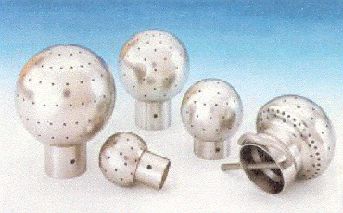
Fig. 1 Stainless steel spray balls
“Cluster” spray heads
This stationary spraying device consist of a multiple orifice body made of PTFE, PVC, PVDF, brass, Hastelloy or sanitary polished 316/316L. The body is fitted with several easy removable solid cone spray or solid stream nozzles. “Cluster” spray heads have a diameter of 5 - 15 cm and a height of 4 - 20 cm. The pressures applied are 0,7 - 35 bar at flow rates of 20 - 600 l/min. For complete liquid drainage, these multiple orifice spraying devices have to be equiped with a lower drain hole.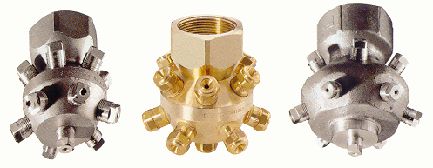
Fig. 2 Cluster spray heads
Spiral tank washing devices
A spiral tank washing device (on the commercial scene also named ‘pigtail’) consists of a continuously descending spiral made of cobalt, nickel-based alloys, stainless steel, brass, zirconium, tantalium, carbide material or PTFE and PVDF. The construction material choice depends on the risk for oxidation, the risk for corrosion, the risk for chemical attack, work area temperature, ... Spiral tank cleaning devices have a length of 5 till 30 cm, with diameters of 2 till 12 cm. They can be mounted in the head of a tank on a (retractable) lance or on a holder, in the later case forming a ‘cluster’ type spraying device with several spiral nozzles.
Fig. 3 Spiral tank washing device
Flat jet nozzles
This type of nozzle with round orifice gives a flat high impact spray pattern deflected over a certain angle. This type of nozzle is constructed from one piece of material, made of stainless steel, brass, PVC, PTFE, ... The flow rates are 2 - 750 l/min at pressures of 0,7 till 15 bar.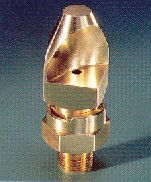
Fig. 4 Flat jet nozzle
| Static spray head | Advantages | Disadvantages |
| Stainless steel spray ball | - acceptable rinsing power for easy removable soil - operating at low pressure - no moving parts - no wear and tear - flexible in maintenance - no generation of static electricity (applicable in explosion risk areas) - small investment price |
- no cleaning power (low impact) - short effective cleaning radius - insufficient surface coverage - only useful in the cleaning of small tanks without internal structures - high consumption of water & cleaning chemicals - high input of energy for the heating of the cleaning liquid - high risk for obstructing the supply line with soil - high atomization risk - high cleaning cost |
| “cluster” spray head | - acceptable rinsing power - alternative to static spray balls due to the higher impingement of the solid jet streams at higher pressure - operating at low pressures - no moving parts - no wear and tear - robust - flexible in maintenance - no generation of static electricity (applicable in explosion risk areas) |
- poor cleaning power - short effective cleaning radius - insufficient surface covarage - only useful in the cleaning of small tanks without internal structures - high consumption of water & cleaning chemicals - high input of energy for the heating of the cleaning liquid - higher contamination risk at the spray nozzle screws - on accidental impact, there is a higher risk for destruction of the equipment wall - poor price/performance ratio (‘spinners’ and the ‘Rokon’ tank washer are more advisable) |
| Spiral tank washing device | - different spray patterns & angles possible - excellent rinsing power - cleaning liquids can contain a lot of particulate materials - free of clogging - high energy efficiency - small pump pressures required - no moving parts - free of maintenance |
- no cleaning power - high water consumption - only usefull in the cleaning of tanks without internal structures - high consumption of liquid & cleaning chemicals - high input of energy for the heating of the cleaning liquid - only suitable for open-top cleaning - excellent drainage of cleaning & rinsing liquid is necessary |
| Flat jet nozzle | - high impact, on the ‘spot’ cleaning especially for not hygienically designed reactors & equipment - minimal clogging - energetically highly efficient - low pump pressure needed - no moving parts - no maintenance |
- there is a need for supplementary supply line - ultimate option, because in advance hygienic equipment design is a better solution |
Rotary spray ball
This stainless steel tank washer consists of a compact spray ball that rotates at 3 - 15 rpm. The rotary cleaning head is driven by the flow of the cleaning fluid due to reactionary forces at the nozzle orifices. A drive system with gears controlling the rotation must avoid in-effectual high speed spinning (a differential speed reduction unit). Spray balls rotating at to high a speed make compact fluid jets to break open very quickly. The impingement effect of solid streams is much higher than full cone sprays. The rotary spray balls are made of Hastelloy or sanitary polished stainless steel 316/316L. Drilled holes or extended nozzles are present over the whole or a fraction of the rotary ball surface. The supply-line must be equiped with a filter to avoid the accumulation of soil within the rotary ball (this is especially a prerequisite in those cases where this body can not be disassembled from the supply-body that contains the differential speed reduction unit). For a maximum self-cleaning of the rotary washer, one nozzle is always directed on the surface of that supply-body and the supply-line. Roller balls can be fixed within the tank in several positions, with the spinning of the tank washer being required in any mounted position. With time, wear to the roller bearings can be the cause of rotary heads starting to block under their own weight. Rotary cleaning heads operating at pressures of 3-14 bar and flow rates of 90-250 l/min have an effective cleaning radius of 1,8 - 2,5 metres and an effective wetting radius up to 4 metres. They are applicable at temperatures of 120°C.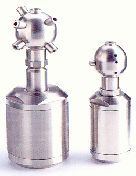
Fig. 5 Rotary Spray Ball
Teflon/PVDF rotary nozzles
The spray ball is constructed of a Teflon/PVDF fluoropolymer resin spray ring that rotates around a solid Teflon/PVDF connection body. The rotating spray ring is kept in place on the connection body by an easily removable external Teflon/PVDF retainer and Viton® O-ring. The connection body is attached to the liquid supply tube by a removable electropolished type 316 stainless steel retaining clip. Multiple holes are slopewise drilled in the spray ring, in a way the physical reaction force from the cleaning solution drives the spray ring around the connection body. To remove the soil between the spray ring and the connection body, the spray ball must be dissambled from time to time. The Teflon/PVDF spray balls operate at low pressures of 0,7 - 3,5 bar in a high temperature range of 150-160°C.
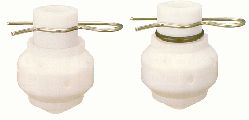
Fig. 6 Teflon/PVDF spray ball
Disc washers
The cleaning fluid is directed through a guide vane onto the disc which instantly rotates, simultaneously dispensing a sphere of heavy, fast moving droplets to the entire surface of the tank. The disc washers are made of Teflon, Hastelloy, electropolished stainless steel 316/316L or a combination of stainless steel/Teflon/PVDF. Some types are constructed in carbon filled PTFE, dissipating static electricity in potentially explosive atmospheres. Working pressures are 2-4 bar at flow rates of 50-270 l/min. The effective cleaning area is 0,5-2,3 m, the effective rinsing radius is 2-3,5 m. They can operate at temperatures of max. 140°C.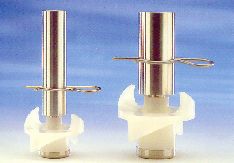
Fig. 7 Rotating disc washers
Spinners
Spinners are rotary tank washers that contain slotted, flat-shaped spray orifices positioned as such, that the water jets generate the reaction forces necessary to produce the rotary motion. The spinners, made in stainless steel 316/316L or Hastelloy have a robust design. They utilize two ball bearing assemblies, that make it possible to operate the nozzle in any orientation. This makes an efficient 360° coverage possible. A spinner can be introduced in a tank through a small flange hole. By this way the spinner can be fixed at different depths by means of a stainless steel lance (316 or 316L). The spinning of the tank washer is required in any mounted position. However, with time, wear to the roller bearings can be the cause of rotary heads starting to block under their own weight.Spinners operate at pressures of 1-3 bar, with a maximum of 7-10 bar. With Mini-spinners the impact cleaning radius and the wetting radius are respectively 0,8-1,4 m and 2-3 m. They can be used in small-sized tanks of 100-10000 l (1-2 internal diameter). With Maxi-spinners the impact cleaning radius and the wetting radius are respectively 1,9-3 m 3,5-4 m. They can be used in large-sized tanks 5000-50000 l (3-4 internal diameter). Both spinner types operate at an optimum of 95°C (with a maximum of 140°C).
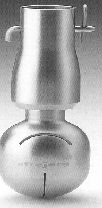
Fig. 8 Spinner
Rokon™ tank washer
Unlike conventional fluid-driven rotating nozzles where the cleaning efficiency decreases as the pressure increases, the Rokon™ rotary tank washing nozzle increases its cleaning impact as the fluid pressure increases. Conventional fluid-driven rotating nozzles, that use the reactionary forces at the nozzle orifices to drive the spray head, spin at to fast a rate, breaking open the fluid streams to small droplets that have a much smaller impact. However, the Rokon™ tank washers that use the momentum of the liquid flow to drive the spray head, contain a differential speed reduction unit. As a consequence, they rotate at a constant speed of approximately 10 rpm even when the fluid pressure is up to 20 bar.The Rokon™ tank washer body is constructed of stainless steel 316 / 316L or chemical- and corrosion resistant KYNAR® (PVDF), with TEFLON® seals and stainless steel elliptic flat spray orifice inserts. The Rokon™ rotary tank washing nozzle can clean tanks up to 4-7,5 m. The flow rates range from 25-100 l/min at pressures up to 16 bar (max. 20 bar). The maximum permitted liquid temperature is 70°C.
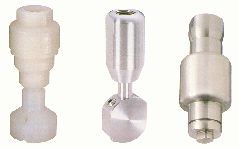
Fig. 9 RokonTM tank cleaning machine
| Rotary spray head | Advantages | Disadvantages |
| Rotary spray balls | - higher efficiency compared to static stainless steel spray balls (due to the higher wetting power over a larger area at a higher spray rate) - more efficient application of the cleaning liquid |
- only small cleaning effect - for cleaning of small to medium sized tanks - frequent maintenance due to wear of the moving parts - risk for soil accumulation at the roller bearing level |
| Teflon/PVDF spray ball | - excellent corrosion resistance to chemicals, at high temperatures - no damage to the tank wall on accidental fall |
- block at high rotation speeds - limited cleaning (rather rinsing) effect |
| Disc washers | - hygienic design (excellent drainage and no clogging) - high self cleaning power - robust - little maintenance - little atomization risk |
- acceptable when thorough cleaning is not a prerequisite - limited spray pattern (area of 1,5-2 m) - blocking by rust or scale particles is a mayor risk |
| Spinners | - swirling high impact cleaning, usefull in tanks where flaky and sticky soil has to be removed - applicable in situations where static and rotary spray balls foul and clog. - operate at low pressure - reduced consumption of water and cleaning chemicals - reduced energy input for the heating of the cleaning liquid - reduced cleaning time - superior price/performance ratio |
- loss of cleaning efficiency at higher pressure (absence of a build-in brake-mechanism that can slow down the rotation speed) - accumulation of dirt in the ball bearings - no plastic variants exist (impracticable in corrosive environments) - higher wear risk - not applicable in explosive atmospheres |
| Rokon™ tank washer | - high-impact cleaning with water consumption being minimized - reduced consumption of cleaning chemicals - reduced energy input for the heating of the cleaning liquid - reduced cleaning time - rotates in every position - free of maintenance - a plastic variant is available - low price/performance ratio |
- higher price |
 Nach oben
Nach oben


 Firmen
Firmen

